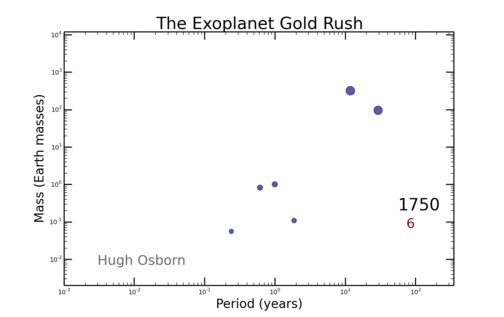Early astronomers realized some of the “stars” in the sky were planets in our Solar System, and really, only then did we realize Earth is a planet too. Now, we’re finding planets around other stars, and thanks to the Kepler Space Telescope, we’re able to find planets that are even smaller than Earth.
This great new graphic of the history of planetary detection was put together by Hugh Osborn, a PhD student at the University of Warwick, who works with data from the WASP (Wide Angle Search for Planets) and NGTS (Next Generation Transit Survey) telescope surveys to discover exoplanets. It starts with the first real “discovery’ of a planet — Uranus in 1781 by William and Caroline Herschel.
“The idea of this plot is to compare our own Solar System (with planets plotted in dark blue) against the newly-discovered extrasolar worlds,” wrote Osborn on his website. “Think of this plot as a projection of all 1873 worlds onto our own solar system, with the Sun (and all other stars) at the far left. As you move out to the right, the orbital period of the planets increases, and correspondingly (thanks to Kepler’s Third Law), so does the distance from the star. Moving upwards means the mass of the worlds increase, from Moon-sized at the base to 10,000 times that of Earth at the top (30 Jupiter Masses).”
You’ll notice a few “clusters” as time moves along. The circles in dark blue are the planets in our Solar System; light blue are planets found by radial velocity. Then in maroon are planets found by direct imaging, followed by orange for microlensing and green for transits.
The first batch of exoplanets were the massive ‘Hot Jupiters’, which were the first exoplanets found “simply because they are easiest to find,” using the radial velocity method. Then you’ll see clusters found by the other methods ending with the big batch found by Kepler.
“This clustering shows that there are more Earth and super-Earth sized planets than any other,” said Osborn. “Hopefully we can begin to probe below it’s limit and into the Earth-like regime, where thousands more worlds should await!”
On reddit, Osborn also provided great, short explanations of the various methods used to detect planets, which we’ll include below:
Radial Velocity
Planets orbit thanks to gravitational attraction from their star’s mass. But the mass of the planet also has an effect on the star – pulling it around in a tiny circle once every orbit. Astronomers can split the light from a star up into it’s colours, which have an atomic barcode of absorption lines in. These lines shift position as the star moves – the light is effectively compressed to bluer colours when moving towards and pulled to redder colours when moving away.
So, by measuring this to-and-fro (radial) velocity, and finding periodic signals, astronomers can detect the tug of distant exoplanets.
Direct Imaging
This is easier to get your head around – point a big telescope at a star and directly image a planet around it. This only work for the biggest young planets as these are warmest, so glow brightest in the infra-red (like a red-hot piece of Iron). To find the planet in the glare of it’s star, the starlight needs to be suppressed. This is done by either blocking it out with a starshade, or digitally combining the images in such a way to remove the central star, revealing new exoplanets.
Microlensing
Einstein’s general theory of relativity shows that mass bends space time. This means that light can be bent by massive objects, and even act like a lens. Occasionally a star with a planetary system passes in front of a distant star. The light from the distant star is bent and lensed by both the star and the planet, giving two sharp increases in brightness over a few days – one for the star and one for the planet. The amount of lensing gives the mass of the planets, and the time between the events gives us the distance from their star. More info
Transits
When a planet crosses in front of it’s star, it blocks out a small portion of sunlight depending on it’s size. We only see the star as a single point, but we can infer the presence of a planet from the dip in light. When this repeats, we get a period. This is how we have found more than 1000 of the current crop of ~1800 exoplanets!
Thanks to Hugh Osborn for sharing his expertise with Universe Today!


I don’t see the pulsar planets discovered in 1992 on there.